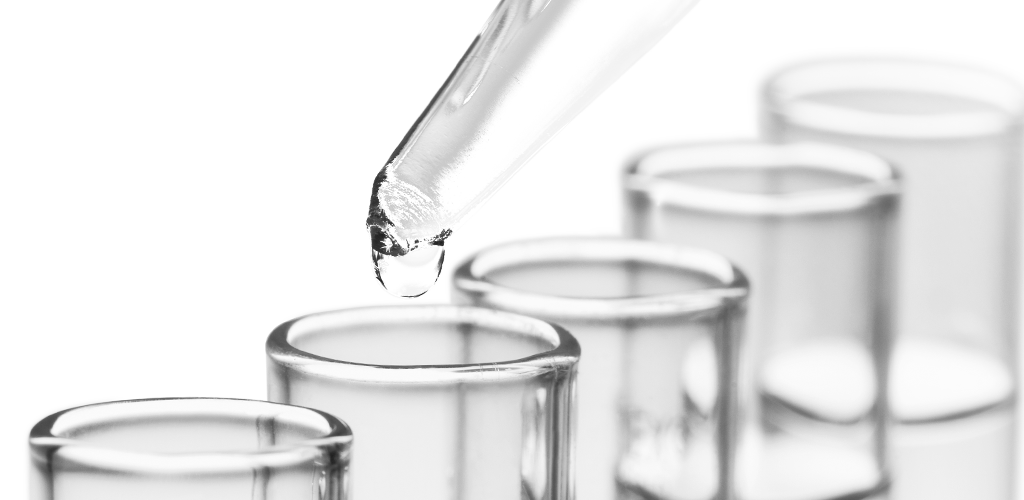Thrombin generation
Biochemistry
The first despriptions of thrombin generation (TG) were published as early as 1986. TG in the classical meaning should be understood as the formation of the thrombin curve after addition of a slow reacting thrombin specific substrate. While routine parameters as Quick and aPTT measure only a part of the coagulation cascade (approx. 2% of the formed thrombin), the TG as global parameter includes the total thrombin formation process.
For determination of thrombin generation the coagulation cascade is activated by addition of different concentrations of TF and phospholipids. The resulting thrombin cleaves a fluorogenic or chromogenic substrate and releases a fluorophor or chromophor. The optical signal is continuously plotted. The fluorogenic measurement is not disturbed by the platelets in platelet rich plasma or by the formation of fibrin. When the thrombin concentration is plotted against time it results in a thrombin generation curve that represents different phases of the coagulation reaction. The evaluation parameters lag phase, velocity index, peak height and Area under the Curve (AUC) can be used for assessment.
As critical parameters that influence the assaying and the interpretation of the TG are primarily tissue factor concentrations, origin and type of the phospholipids, use of platelet rich or platelet poor plasma as well as general lack of standardizing of the evaluation to be mentioned.
The thrombin generation thus includes the total kinetic of the thrombin formation: the initial phase of the thrombin formation, the phases of amplification with positive feedback, the downregulation of the thrombin formation and the inactivation of the formed thrombin.
Indication
- Monitoring of Inhibitor-Bypass-Therapy in hemophiliac patients
- Monitoring of anticoagulant therapy
- Risk evaluation by thrombosis recurrence
- Determination of the coagulation activity of microparticles
Literatur
- Fareed J, Hoppensteadt DA, Leya F et al. Useful laboratory tests for studying thrombogenesis in acute cardiac syndromes. Clin Chem 44, 1845-1853, 1998.
- Stief TW. Specific determination of plasmatic thrombin activity. Clin Appl Thromb Hemost 12, 324-329, 2006.
- Triplett DA. New methods in coagulation. Crit Rev Clin Lab Sci 15, 25-84, 1981.
- Hutton RA. Chromogenic substrates in haemostasis. Blood Rev 1, 201-206, 1987.
- Hemker HC, Al Dieri R, De Smedt E et al. Thrombin generation, a function test of the haemostatic thrombotic system. Thromb Haemost 96, 553-561, 2006.
- Stief TW, Wieczerzak A, Renz H. Influence of coagulation factors on extrinsic thrombin generation. Blood Coagul Fibrinolysis 18, 105-112, 2007.
- Stief TW, Otto S, Renz H. The intrinsic coagulation activity assay. Blood Coagul Fibrinolysis 17, 369-378, 2006.
- Stief TW. Thrombin generation by exposure of blood to endotoxin: A simple model to study disseminated intravascular coagulation. Clin Appl Thromb Hemost 12, 137-161, 2006.
- Stief TW, Otto S, Renz H. Influence of coagulation factors on intrinsic thrombin generation. Blood Coagul Fibrinolysis 18, 67-71, 2007.
- Stief TW, Fröhlich S, Renz H. Determination of the global fibrinolytic state. Blood Coagul Fibrinolysis18, 479-487, 2007.
- Narayanan S, Hamasaki N. Current concepts of coagulation and fibrinolysis. Adv Clin Chem 33, 133-168, 1998.
- Hoffman M, Monroe DM. Coagulation 2006: A modern view of hemostasis. Hematol Oncol Clin North Am 21, 1-11, 2007.
- Mackie IJ, Bull HA. Normal haemostasis and its regulation. Blood Rev 3, 237-250, 1989.
- Ickx BE. New anticoagulant drugs: Monitoring and perioperative strategies. Acta Anaesthesiol Belg 57, 409-418, 2006.
- Fareed J, Hoppensteadt DA, Bick RL. Management of thrombotic and cardiovascular disorders in the new millenium. Clin Appl Thromb Hemost 9, 101-108, 2003.
- Agnelli G, Becattini C. New anticoagulants. Semin Thromb Hemost 32, 793-802, 2006.
- Kalz J, ten Cate H, Spronk H. Thrombin generation and atherosclerosis. J Thromb Thrombolysis. Jan 37(1), 45-55, 2014

